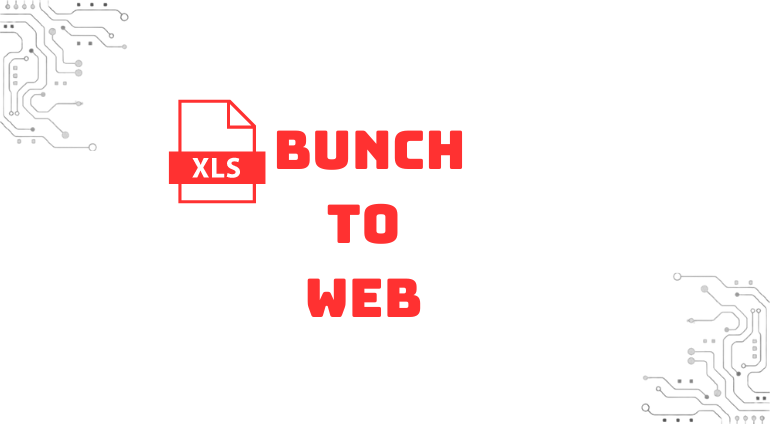
Transforming a collection of disconnected Excel files into a comprehensive, complete, and stand-alone web application offers numerous benefits for organizations. Here are some key advantages:
1. Enhanced Accessibility and Collaboration
> Anywhere, Anytime Access: Unlike Excel files, which are typically stored locally or on shared drives, a web application can be accessed from anywhere with an internet connection, enabling
remote work and collaboration.
> Real-Time Collaboration:
Multiple users can work on the web application simultaneously without version conflicts, ensuring everyone
has access to the most up-to-date information.
2. Improved Data Integrity and Security
> Centralized Data Management: A web application centralizes data storage, reducing the
risk of data duplication and inconsistencies common with multiple Excel files.
> Enhanced Security:
Web applications can incorporate advanced security measures, including encryption, access
controls, and regular backups, to protect sensitive business data.
3. Streamlined Operations and Efficiency
> Automation of Repetitive Tasks: Web applications can automate repetitive tasks such as data entry,
calculations, and report generation, reducing manual effort and the potential for errors.
> Integrated Workflow:
A well-designed web application can integrate various business processes, providing a
seamless workflow that enhances operational efficiency.
4. Scalability and Flexibility
> Easy Scaling: Web applications can easily scale to accommodate growing data
and user numbers, unlike Excel files, which can become cumbersome and slow as they grow in size.
> Customizable and Extendable:
Web applications can be customized and extended with new features and functionalities as
business needs evolve, providing a flexible solution that grows with the organization.
5. Advanced Data Analytics and Reporting
> Sophisticated Analytics: Web applications can leverage advanced analytics tools
to provide deeper insights into business operations, helping in data-driven decision-making.
> Dynamic Reporting:
Users can generate dynamic, real-time reports with interactive visualizations, making it
easier to analyze trends and performance metrics.
6. Enhanced User Experience
> Intuitive Interfaces: Web applications can offer user-friendly
interfaces with better navigation and usability compared to Excel spreadsheets.
> Consistent User Experience:
A web application ensures a consistent user experience across different devices and
platforms, improving user satisfaction and productivity.
By transitioning from a bunch of disconnected Excel files to a comprehensive web application, organizations can enhance accessibility, security, and efficiency, ultimately driving better business outcomes and supporting growth.

This is what you gain with your own web application:
Switching to a web application can drive better business outcomes, support growth, and give you a competitive edge in today's fast-paced digital landscape. Imagine a world where your operations run smoothly, your data is secure, and your team collaborates effortlessly.
Don’t let outdated processes hold your business back. Contact us now to learn how our custom web application solutions can transform your business operations and drive growth. Let’s work together to build a more efficient, secure, and scalable future for your organization.
A: The process begins with a thorough analysis of the interconnected Excel files to understand their inherent functionality and logic. This involves:
1. Data mapping: Identify and document the data flow and relationships
between the files.
2. Functionality Extraction: Extract key calculations, formulas, and processes
embedded within the spreadsheets.
3. Use Case Identification: Determine the primary use cases and workflows
the files support.
4. Requirement Gathering: Translate the extracted functionality and use
cases into detailed requirements for the web application.
This analysis serves as the foundation for designing a web application that replicates and enhances the capabilities of the original Excel files, ensuring a seamless transition and improved user experience.
A: The duration of transitioning from a bunch of disconnected Excel files to a comprehensive web application can vary depending on several factors. Typically, the process includes the following phases:
1. Initial Analysis and Requirement Gathering (1-2 weeks): This involves thoroughly analyzing
the existing Excel files, understanding their functionality, and gathering detailed requirements
for the new web application.
2. Design and Planning (2-4 weeks): During this phase, we design the architecture of the
web application and plan the development process. This includes creating wireframes, user interfaces,
and determining the necessary technical stack.
3. Development (4-12 weeks): The core development phase where the web application is built,
based on the analyzed functionality and design plans. The duration of this phase can vary depending
on the complexity and features required.
4. Testing and Quality Assurance (2-3 weeks): Rigorous testing is conducted to ensure the
web application functions correctly, is secure, and meets all specified requirements.
5. Deployment and Training (1-2 weeks): The final phase involves deploying the web application
and training users to ensure a smooth transition from the Excel-based system.
In total, the process can take anywhere from 10 to 23 weeks. However, this timeline can vary based on the complexity of the Excel files, the specific requirements of the web application, and the resources available. Our team will work closely with you to provide a more accurate timeline tailored to your project's needs.
A: Maintaining and evolving your web application is crucial to ensuring its continued effectiveness and relevance as your business grows and changes. As your trusted partner, we offer comprehensive services to help you manage this process seamlessly:
1. Regular Updates and Maintenance:
> Scheduled Maintenance: We perform regular maintenance to keep your application running smoothly,
including updating software libraries, fixing bugs, and improving performance.
> Performance Optimization: Our team continually refines and optimizes your application to
enhance speed, efficiency, and user experience.
2. Monitoring and Analytics:
> Performance Monitoring: We use advanced monitoring tools to track the application's
performance, identify issues, and optimize resource usage.
> User Analytics: We collect and analyze user data to understand how the application
is being used and identify areas for improvement.
3. Feedback and User Support:
> User Feedback: We encourage and manage user feedback to identify pain points and
new feature requests, ensuring your application meets user needs.
> Support System: Our robust support system assists users with any issues they
encounter, ensuring a positive user experience.
4. Scalability and Future-Proofing:
> Scalable Architecture: We design and update your application with scalability
in mind to handle increased traffic and data as your business grows.
> Future Enhancements: Our team stays ahead of emerging technologies and
industry trends to recommend and implement future enhancements that benefit your application.
5. Documentation and Training:
> Comprehensive Documentation: We maintain up-to-date documentation of the application’s
codebase, architecture, and features, facilitating easier maintenance and onboarding of new developers.
By partnering with us, you can ensure that your web application remains robust, secure, and adaptable to future business requirements. Our dedicated team is here to provide the ongoing support and development services you need to maintain and evolve your application successfully.